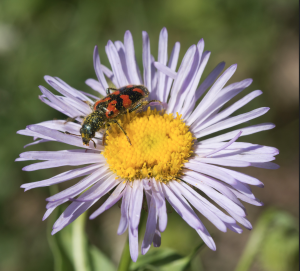Week 8: Reading
Gail Langellotto and Melissa Scherr
Pollinators

Animals pollinate an estimated 80% of the world’s flowering plants (Ollerton et al. 2011) and 75% of global crop species (Klein et al. 2007) (figure 8-1). Pollinators are critical to fruit production and seed set in many of Oregon’s key crops, including tree fruits, berries, melons, and specialty seed crops (e.g. carrot seed). Not only do pollinators increase crop yield, but in many cases, they improve crop quality.
Pollinators visit flowers to collect nectar for flight fuel and pollen for brooding; nectar is a good source of carbohydrates, while pollen is a good source of protein. When a pollinator visits a flower in search of food, they often brush against plant reproduction structures. When they move between flowers (for dioecious or monoecious plants) or within a flower (for plants with perfect flowers), pollinators can transfer pollen from the anther to the stigma, thus facilitating fertilization.

Bees are arguably the most efficient and most effective of pollinators. Other types of insect pollinators include flies, ants, wasps, beetles, butterflies, and moths. Vertebrate pollinators include hummingbirds, bats, and even rodents. The first pollinators were thought to be beetles feeding on conifer sap that forms on cones, and the resultant pollination efficiency as the beetles moved between male and female cones drove the evolution of the Angiosperms and their flowers. The first angiosperms reliant on pollination by insects were typically open-faced flowers with shallow food resources or fleshy petals: there needed to be an accommodation for both the larger stance of the beetle and unadapted chewing mouthparts. Many of these beetles still feed on primitive angiosperms at least in part, like the predatory Checkered Flower beetle that feeds on Oxeye Daisy pollen in the spring months (figure 8-2).
In the 145 million years since the evolution of flowering plants, highly specialized adaptations for efficient and effective pollination have arisen. For example, the honey bee body has a slight electrostatic charge, which attracts pollen grains to their bodies. Honey bees have bifurcated setae (i.e. branched hairs) covering their body, which helps to hold on to pollen grains. They also have scopae (singular = scopa), which are dense tufts of hair (in leafcutter bees or sweat bees) or depressions on their hind legs (also known as corbicula, in bumblebees and honey bees) that allows them to pack and transport large numbers of pollen grains on their body. Because female bees collect pollen not only for themselves, but also to provide food for their larvae, the scopae of females bees is much more developed than on males.
Honey bees are arguably the most famous of the insect pollinators. Currently, they are used to pollinator over 100 commercial crops in North America. Honey bees are a popular choice for crop pollination because they can be managed to meet crop needs. Although the natural nesting habit for honey bees is in tree hollows, they have been domesticated to nest in artificial hives. These hives can be transported to crop fields, during critical pollination periods. The pollination services offered by honey bees are so valuable, that most commercial beekeepers make the bulk of their money by renting hives to growers, rather than from honey, beeswax, or other hive products.
However, honey bees are just one of the estimated 4,000 species of bee that can be found in North America. Many crops require buzz pollination, and honey bees may not be the most efficient pollinator ; instead, bumblebees, carpenter bees, and leafcutting bees (most of which are native bees, and all of which can perform buzz pollination) are expected to be better pollinators for crops in the genus Solanum(e.g. tomatoes, eggplant) and Vaccinium(e.g. blueberries, cranberries). In Oregon, especially in the Coastal Regions, we have many species of native bees better adapted to the climate and pollination in windy/rainy weather, making them a better option for many of theVaccinium crops.
About 70% of North America’s native bee species nest in the ground. An estimated 30% of native bees nest in wood tunnels, pithy stems, or other cavities. Brush piles, rock piles, and even old rodent burrows can serve as nest sites for bee species. Often, there is little known about these solitary ground nesters, including phenology, basic biology and even identification of species. As a result, it is difficult to understand the economic impact of these organisms on production, and difficult to make a case for the protection of these species.

Ground nesting, solitary life history strategies, annual nests and generally cryptic behaviors make it difficult to both suppress crop pests but protect crop pollinators. Often, the management method that suppresses a crop pest (such as tilling, or pesticide use) can harm or kill insect pollinators. In addition, many crops are planted in large monocultures, which may not provide the variety that pollinators need for a healthy diet. Additionally, most pollinator protection plans focus on bees and butterflies (the latter being an inefficient pollinator), overlooking other important pollinators like beetles and flies. We have only recently started to evaluate the pollination contributions of hover flies (figure 8-3), insects emerging in the very early spring with a big impact on early-flowering plants. However, the loss of natural areas to urban and agricultural development can reduce available forage for all of these pollinators, as can the broad scale control of weeds.
Despite these challenges, pollinator protection can be incorporated into integrated pest management plants, to meet crop production goals while protecting this important natural resource. There are simple steps that farm managers can take, to help protect pollinators.

